#newyorkcitygolfcourses
Text

NYC Skyline as Seen from Kissena
A fantastic sunset over the 2nd green at Kissena Park Golf Course with the Manhattan skyline visible on the horizon.
#golf#golfcourse#newyork#newyorkcity#nyc#publicgolf#municipalgolf#muni#nycgolf#nycgolfer#newyorkcitygolfcourses#nycgolfcourses#golfarchitecture#golfart#photography#golfphotography#lovegolf#queens#kissena#sunset#skyline#manhattan
1 note
·
View note
Photo


I’ve been meaning to make the short trip across the Hudson River to Jersey City to play the nine-hole Skyway Golf Course, which opened in 2019. While it’s located outside of the five boroughs, I really wanted to see the views of lower Manhattan from the course. The views of One World Trade Center were amazing. Pictured here is the skyline as seen when standing behind the second green and from the third fairway.
#golf#golfcourse#newyork#nyc#publicgolf#municipalgolf#muni#map#nycgolf#golfart#golfcourseart#newyorkcitygolfcourses#nycgolfcourses#golfarchitecture#jerseycity#skywaygolfcourse#oneworldtradecenter
0 notes
Photo



Forest Park Golf Course - Hole 5
The 5th hole at Forest Park Golf Course in Queens is one of the most severe doglegs in the City. Typically, doglegs offer players a choice: try to hit, in the words of Bernard Darwin, a “long and daring driver” along the curve of the hole to leave a short approach shot, or play a tee shot safely down the middle leaving a longer second shot. No such choice is available on the 5th hole, though, because the trees to the right of the tee are simply too tall and dense to try to cut the corner. Instead, to reach the green in regulation, players must hit two long and straight shots, each approximately 200 yards. The second shot is especially demanding due to the severe slope that guards the left side of the hole and the hazard that runs along the right side of the fairway and green.
#golf#golfcourse#newyork#nyc#publicgolf#municipalgolf#muni#map#nycgolf#golfart#golfcourseart#newyorkcitygolfcourses#nycgolfcourses#golfarchitecture#queens#forestpark
1 note
·
View note
Photo

Straphanger Series Part 2 - 7 Train to Flushing Meadows Pitch & Putt
This is the second installment of a four-part series detailing the four courses in New York City that stuck out to me as the easiest to access via public transportation. For the purposes of this series, I’ve illustrated the trips to these courses from central Manhattan (either Times Square or Grand Central Station).
Flushing Meadows Pitch & Putt is located in Flushing Meadows Corona Park in Queens. Straphangers can catch the 7 train at Grand Central and ride 17 local stops (generally about 30 minutes) to Mets-Willets Point station (if you catch the train running express, you cut a fair amount of time off the trip). While walking from the subway station to the clubhouse you'll see Citi Field, home of the New York Mets, as well as the US Open’s USTA Billie Jean King National Tennis Center, including Arthur Ashe Stadium.
#golf#golfcourse#newyork#nyc#publicgolf#municipalgolf#muni#map#nycgolf#golfart#golfcourseart#newyorkcitygolfcourses#nycgolfcourses#golfarchitecture#flushingmeadowspitchandputt#queens#manhattan#mta#subway
1 note
·
View note
Photo


I’m very excited to be back online for the 2022 season! While the courses are still recovering from the winter, spring golf in the City is quite beautiful. If you can get out and play sometime over the next few weeks, there’s a good chance you’ll spot some blooming magnolias, dogwood flowers (pictured here at Mosholu Golf Course in early June 2021), and cherry or apple blossoms (pictured here at Kissena Park Golf Course in late April 2021).
#golf#golfcourse#newyork#nyc#publicgolf#municipalgolf#muni#nycgolf#golfart#golfcourseart#golfphotography#photography#newyorkcitygolfcourses#nycgolfcourses#golfarchitecture#queens#kissenapark#bronx#mosholu#spring#flowers#blooming#blossoms#magnolia#dogwood#cherry blossom
0 notes
Photo
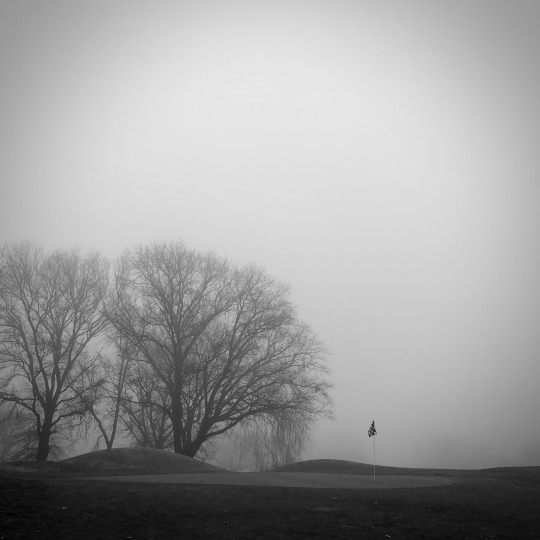
Winter golf in New York City has a completely different ambiance. The leaves are gone, the grass is dormant, it’s cold, and the weather is often a challenge. Here’s a photo of the 10th green at Kissena Park Golf Course taken during a foggy afternoon round in December.
#golf#golfcourse#newyork#nyc#publicgolf#municipalgolf#muni#nycgolf#golfart#golfcourseart#golfphotography#photography#newyorkcitygolfcourses#nycgolfcourses#golfarchitecture#queens#kissenapark
0 notes
Photo

Van Cortlandt circa 1895 vs. 2021
After determining the specific location of the original 9 holes at Van Cortlandt, I could then compare the original layout with the current course. To do so, I overlaid maps dating from around the time the course was built onto contemporary satellite imagery available on Google Earth. While the roads in the park have changed substantially since 1895, the train tracks and lake are good reference points because they have remained consistent over the years.
Based on all the information I had reviewed, here are my conclusions: the current routing does not include any of the original holes; however, holes 1, 2, 3, 7, 12, 13, and 14 are located on the same land as the original 9 holes.
Around the same time I was working on this analysis, I discovered that the New York City Department of Parks & Recreation published an article describing the history of golf in the City’s parks. In the article, the Parks Department similarly stated that the original routing at Van Cortlandt was located on what is now holes 1, 2, 3, 7, 12, 13, and 14. One difference is that the Parks Department also added the current 6th hole to the list. Based on the information I saw, I could not conclude definitively one way or the other where the 6th hole fit in. Unfortunately, there are no sources referenced in the Parks Department article that provide a clear answer.
#golf#golfcourse#newyork#nyc#publicgolf#municipalgolf#muni#nycgolf#golfart#golfcourseart#newyorkcitygolfcourses#nycgolfcourses#golfarchitecture#bronx#vancortlandt
0 notes
Photo

I’ve played each of the past three weeks, and this weekend seems like it will be peak fall foliage in New York City. Courses not only look great with the colorful leaves, but the greens I’ve played have been especially good after fully recovering from fall aeration. Pictured here is the fairway-wide bunker that bisects the 11th hole at Split Rock Golf Course.
#golf#golfcourse#newyork#nyc#publicgolf#municipalgolf#muni#nycgolf#golfart#golfcourseart#newyorkcitygolfcourses#nycgolfcourses#golfarchitecture#bronx#splitrock#golfphoto#golfphotography
0 notes
Photo
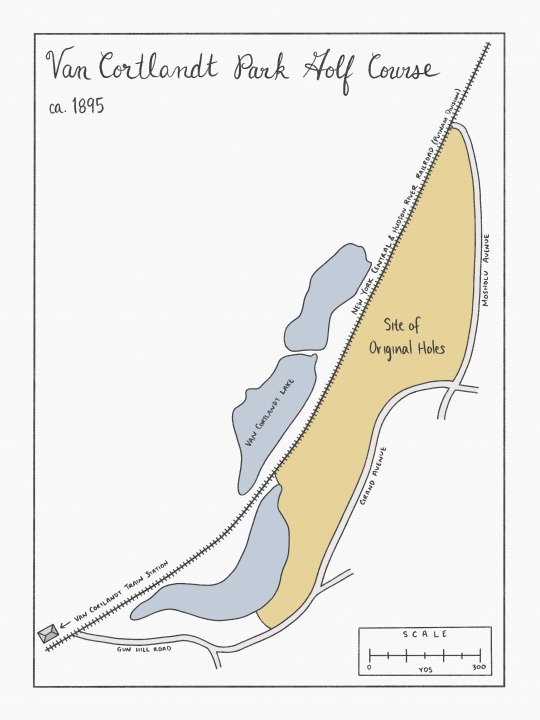

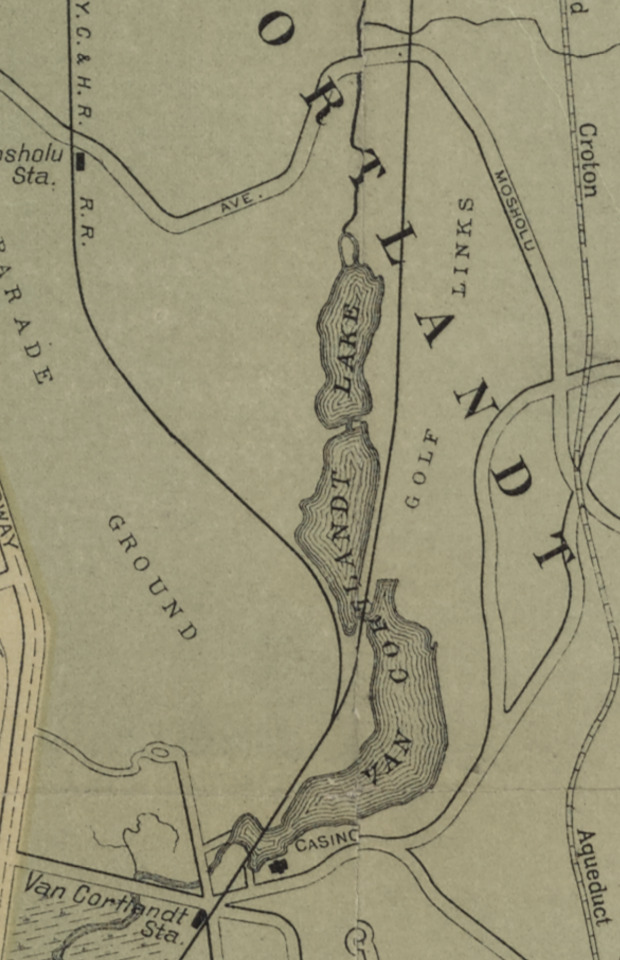
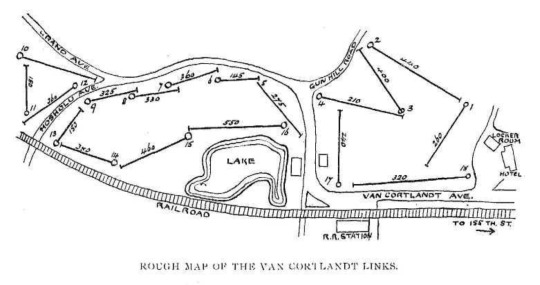
Where were the Original 9 Holes at Van Cortlandt Park Golf Course?
It’s well-known that Van Cortlandt Park Golf Course in the Bronx is the Country’s oldest public course. Apart from this general fact, though, I really had no idea whether Van Cortlandt circa 2021 is at all similar to Van Cortlandt circa 1895. In particular, I always found myself wondering if the course we play today includes any of the original holes built on the property. Fortunately, there are a few contemporaneous historical records that provide good reference points to compare today’s course with the original layout. Unfortunately, it is unlikely that we are playing any of Van Cortlandt’s original holes today.
I reviewed two records that proved to be especially helpful in this assessment. First, The Sun published an article in November 1896 describing interest in an amateur tournament scheduled to be played at Van Cortlandt. The article included a diagram of the course layout and a description of each hole.
The second record was the May 1899 issue of “Golf,” which is the USGA’s official bulletin. The publication included a nine-page article, titled “Golf at Van Cortlandt,” which described the history of golf in the park and plans to change the original 9-hole routing into 18 holes. Of particular interest, the author sketched a map of the property and provided descriptions of how each of the original 9 holes would be changed during the expansion process.
The drawings published by The Sun and the USGA were helpful because they provided the boundary lines that defined the original routing, including Mosholu and Grand Avenues to the East, the New York Central & Hudson River Railroad: New York & Putnam Division train tracks to the West, and Van Cortlandt Lake to the South. With these landmarks to work with, it’s possible to locate the original land area the course occupied using historical maps of Van Cortlandt Park (see above for a helpful portion of a 1903 map from the New York Public Library’s collection).
Based on all these sources, I created the above-referenced, to-scale map showing where the original 9 holes at Van Cortlandt were located.
#golf#golfcourse#newyork#nyc#publicgolf#municipalgolf#muni#map#nycgolf#golfart#golfcourseart#newyorkcitygolfcourses#nycgolfcourses#golfarchitecture#bronx#vancortlandtpark
0 notes
Photo

Earlier this year, I posted about three of Van Kleek’s most compelling green complexes throughout the City (Post 1, Post 2, and Post 3). The “Dyeabolical” 18th green at Whistling Straits, which should be a spot of excitement for this weekend’s Ryder Cup, initially helped me connect the dots between the three courses in NYC. All four greens are dramatically shaped with very distinct arms, which create the interesting possibility that a player will have a putt without a direct line between the ball and hole.
Note - the 18th green at Whistling Straits previously extended through the dotted line in the top-left quadrant of the image, above.
#golf#golfcourse#newyork#nyc#publicgolf#municipalgolf#muni#map#nycgolf#golfart#golfcourseart#newyorkcitygolfcourses#nycgolfcourses#golfarchitecture#statenisland#bronx#brooklyn#latourettegolfcourse#pelhambay#dykerbeach#whistlingstraits#rydercup#dyeabolical
0 notes
Photo

The previous post assessed the potential correlation between the total yardage and difficulty of New York City’s municipal courses. On the one hand, some of the longest courses in the City were indeed rated the most difficult. On the other hand, some shorter courses played relatively more difficult than longer courses. This follow-up post examines how the two shortest full-length courses (Kissena and Mosholu) could be rated more difficult relative to par than South Shore, which is more than 1,500 yards longer.
The graph above and the table below, which show the breakdown of holes by par at each course, provide some helpful insights when comparing Kissena, Mosholu, and South Shore. The two shorter courses are outliers in that they have no par 5 holes. On the opposite end of the spectrum, South Shore has four par 5 holes, which is tied with Marine Park for the most in the City. Par 5's are interesting in that they tend to play much easier than par 3’s and par 4’s. According to Shot Scope data, for example, a near-scratch golfer averages 3.34 strokes on a par 3, 4.39 strokes on a par 4, and 5.02 strokes on a par 5. In other words, substituting four par 5 holes at South Shore with four additional par 3 holes at Kissena and Mosholu could amount to an average difference of about 1.3 strokes relative to par over the course of 18 holes. Given the abundance of par 5 holes at South Shore, coupled with the fact that two of the four par 5’s are actually quite short (approximately 450 yards), it’s understandable that Kissena and Mosholu could play more difficult relative to par.
NYC Public Courses: Number of Holes by Par Course Total Par 3 Holes Total Par 4 Holes Total Par 5 Holes Kissena Park 8 10 0 Mosholu 8 10 0 Douglaston 7 9 2 Van Cortlandt 5 10 3 Forest Park 5 10 3 South Shore 4 10 4 Silver Lake 4 12 2 Clearview Park 4 12 2 Dyker Beach 4 11 3 Pelham Bay 4 11 3 Split Rock 3 12 3 La Tourette 3 12 3 Ferry Point 4 11 3 Marine Park 4 10 4
Note – some scorecards list two potential pars for some holes, either “4/5” or “5/4.” For the sake of consistency, I always selected the first of the two numbers presented. In the case of South Shore, this meant that the 2nd hole (457 yards, listed as “5/4”) was counted as a par 5 and the 16th hole (379 yards, listed as “4/5”) was counted as a par 4.
#golf#golfcourse#newyork#nyc#publicgolf#municipalgolf#muni#map#nycgolf#golfart#golfcourseart#newyorkcitygolfcourses#nycgolfcourses#golfarchitecture#bronx#queens#brooklyn#statenisland
0 notes
Photo

This is a bar graph of the total yardage of each full-length public course in New York City vis-à-vis a scatter plot of the rating of each course from the back tee boxes (the scatter plot depicts the difference between the course rating and par; if the course rating is lower than par, a scratch golfer is expected to break par, and vice versa). The same information is presented below in a table. While it’s tempting to conflate distance and difficulty, the two do not necessarily correlate based on these data. Although there does appear to be some support for an overall argument that longer courses play more difficult (for example, three of the four courses expected to play over par for scratch golfers are also three of the four longest courses in the City), some of the shorter courses actually play relatively more difficult than the longer courses — Kissena (4,511 yards) and Mosholu (4,624 yards) are rated more difficult than South Shore (6,268 yards), for example, and Van Cortlandt (6,002 yards) is expected to be slightly more difficult than La Tourette (6,708 yards).
NYC Public Courses: Distance vs. Difficulty for a Scratch Golfer Course Total Yards from Back Tees Expected Score Relative to Par Kissena Park 4,511 -1.8 Mosholu 4,624 -1.6 Douglaston 5,469 -1.1 Van Cortlandt 6,002 -0.2 Forest Park 6,053 -1.6 South Shore 6,268 -2 Silver Lake 6,304 +0.4 Clearview Park 6,328 -0.1 Dyker Beach 6,438 -0.5 Pelham Bay 6,480 -0.3 Split Rock 6,682 +2 La Tourette 6,708 -0.4 Ferry Point 6,867 +3.2 Marine Park 7,007 +1.3
Note – the tee box selected for Ferry Point is the Gold tee box, not the very back tee box. It was my understanding that the very back tees are not consistently available on the course as they are intended for professional and championship play (these tees measure 7,407 yards with a course rating of 76.3, which is 5.3 shots over par).
#golf#golfcourse#newyork#nyc#publicgolf#municipalgolf#muni#map#nycgolf#golfart#golfcourseart#newyorkcitygolfcourses#nycgolfcourses#golfcoursearchitecture#bronx#queens#brooklyn#statenisland
0 notes
Photo



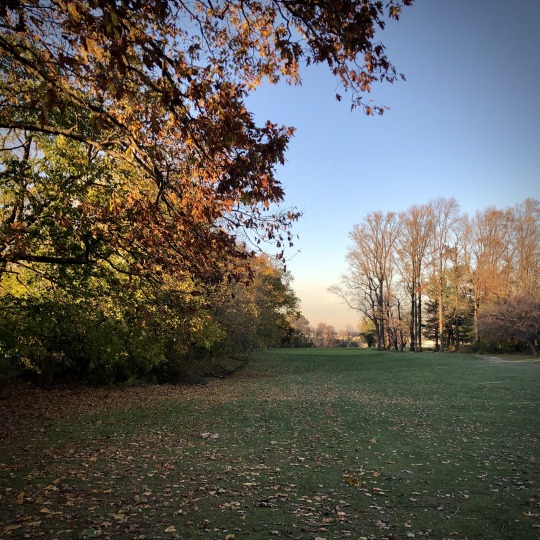
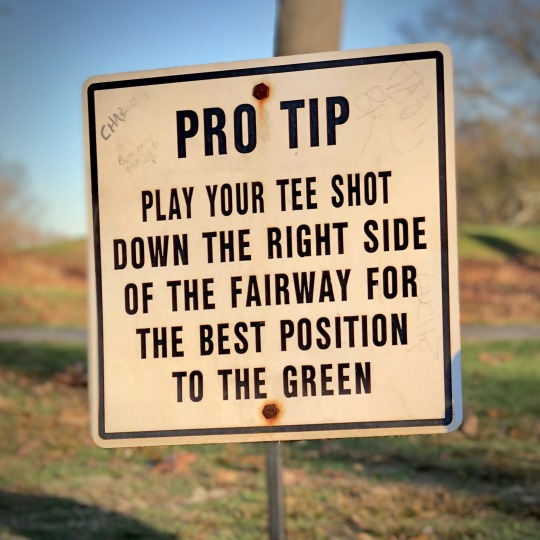
Clearview Park Golf Course Routing - Part III
This is the third and final installment in a series exploring the routing of Clearview Park Golf Course in Queens. These posts have assessed the intersection between the shape of the course and its impact on the surrounding area of the City. In particular, does the design of certain holes reward tee shots hit away from the edge of the property?
The 8th hole, a straightaway par 4 measuring 430 yards from the back, boasts one of New York City’s most picturesque tee shots. The tee box is set at the top of a hill (the hole runs downhill with the green approximately 50 feet below the tee), and the Throgs Neck Bridge is visible on the horizon. There is out-of-bounds and trouble along the left side of the hole — a tee shot hit left may land in the housing located on 202nd Street. Similar to the 5th hole, there is a “Pro Tip” adjacent to the tee box indicating that a drive that lands in the right side of the fairway will leave an ideal approach shot to the green.
Is there a reward for hitting a tee shot up the right side of the fairway vs. the left side? I again believe the Pro Tip is accurate. Similar to the 5th hole, the terrain leading to the 8th green is generally flatter on the right side. In this case, there is a sprawling, shallow depression in the ground short of the green in the left rough. A second factor favoring the right side of the hole is tree trouble for mishit drives. There are trees lining both sides of the rough (isolated stands of trees on the right, and tree limbs that poke out a fair amount from the woods on the left). A punch shot from the right rough can run up through the fairway onto the green; in contrast, a punch shot from the left rough may get tangled up in the depression in the rough short of the green, and tree limbs could block out a high-lofted approach. Taken together, a smart tee shot will be aimed towards the right side of the 8th fairway.
#golf#golfcourse#newyork#nyc#publicgolf#municipalgolf#muni#map#nycgolf#golfart#golfcourseart#newyorkcitygolfcourses#nycgolfcourses#golfarchitecture#clearviewpark#queens
0 notes
Photo

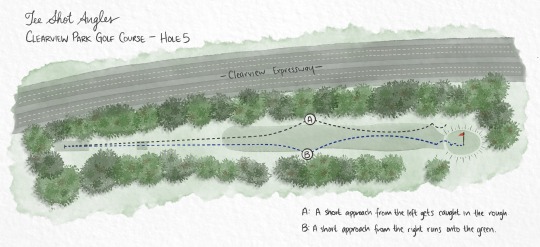

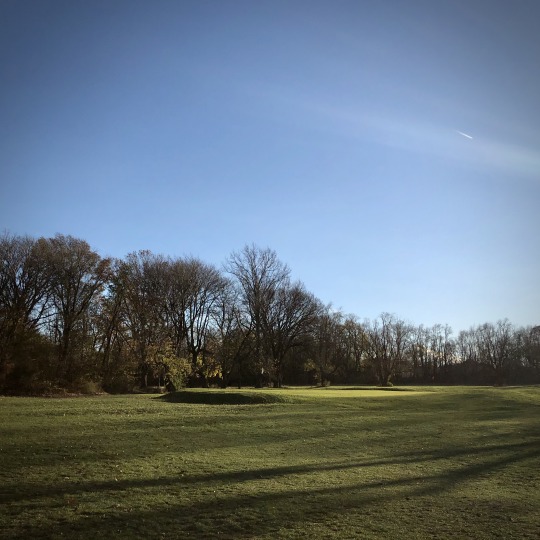

Clearview Park Golf Course Routing - Part II
This is the second post in a series exploring the routing of Clearview Park Golf Course. As discussed in the first post, there are a number of holes on the front nine that wrap clockwise around the perimeter of the property and present a lingering danger of hitting a ball left, out-of-bounds, into the streets and housing surrounding the course. In order to mitigate this risk, Clearview sought to design holes that reward tee shots that are hit away from the out-of-bounds line to the right side of the holes.
The first time players encounter this design strategy is on the fifth hole. The fifth hole is a straightaway 405-yard par 4 from the back tee box. The hole plays longer than the actual yardage because it runs along a constant, gradual uphill slope (the tee box is approximately 40 feet below the green). The most dramatic aspect of the hole is the six-lane Clearview Expressway (Interstate 295) that runs parallel to the hole on the left, connecting traffic between Queens and the Bronx. The course and expressway are separated by a line of trees, but the highway is clearly visible when teeing off. Adjacent to the tee box is a warning sign and a “Pro Tip,” which indicates that a drive that lands in the right side of the fairway will leave an ideal approach shot to the green.
Does the design of the fifth hole actually reward drives that land in the right side of the fairway? In my opinion, the Pro Tip is accurate. The green is set on a slight plateau. The plateau drops off steeply into the rough on the left side of the green, whereas the fairway bottlenecks into a gradual ramp leading to the right side of the green. A shot can therefore run up the ramp of the fairway onto the green from the right side of the hole, whereas a shot played from the left side of the hole has to carry all the way to the green. This difference is compounded when considering that amateurs generally tend to come up short on approach shots (see e.g., statistical analysis of approach shots), and the gradual uphill slope of the hole can trick players into under clubbing. If the approach shot does come up short, a chip from the fairway on the right will be easier (and present more options) than a shot that comes up short on the left, where the only hope is some kind of lofted chip from the rough.
#golf#golfcourse#newyork#nyc#publicgolf#municipalgolf#muni#map#nycgolf#golfart#golfcourseart#newyorkcitygolfcourses#nycgolfcourses#golfarchitecture#clearviewpark#queens
0 notes
Photo


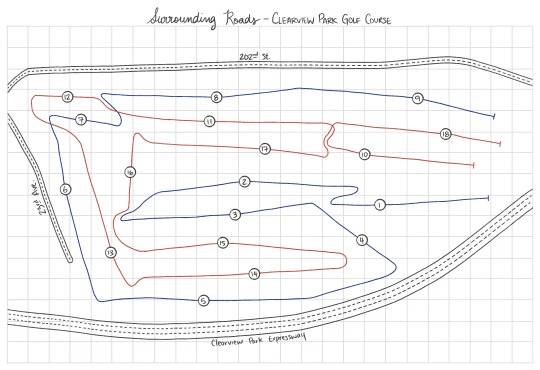

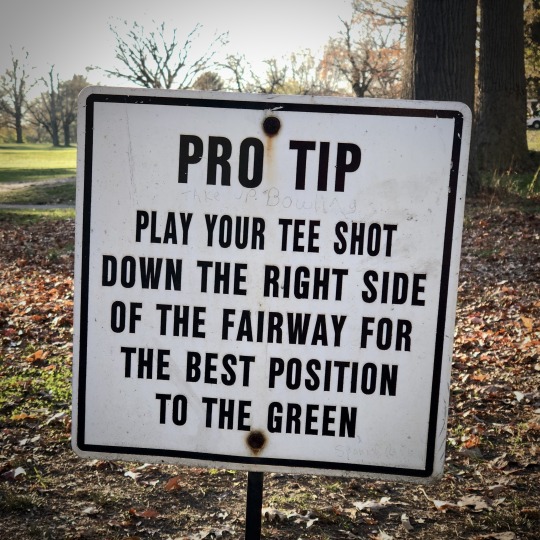
Clearview Park Golf Course Routing - Part I
This is the first in a series of three posts highlighting the intersection between the routing of the Clearview Park Golf Course and its impact on the surrounding area of the City.
The first diagram, above, shows the general routing of Clearview Park. The second diagram shows the path a player would walk when completing the first and second nines. While the two halves of the course are not perfect concentric circles, the first nine largely wraps around the edge of the property in a clockwise direction, whereas the second nine is primarily laid out within the confines of the first nine.
The third diagram shows the layout of the course along with the roads surrounding the property. Streets and housing closely circle most of the course. One consequence of this overall layout is that as players wrap around the edge of the property on the front nine (holes 5, 6, 8, and 9), there is an ever-present threat that a shot hit to the left will land out-of-bounds in the surrounding roads and neighborhoods. It’s therefore no surprise to find warning signs on the course: “You are responsible for any injury to people or damage to property caused by your actions including errant golf shots.”
The course has taken steps to mitigate the effect of a badly pulled/hooked shot (or badly pushed/sliced shot for a left-handed player). Most prominently, there are giant nets strategically placed throughout the course to block mishit tee balls. Another preventative step involves the architecture of the holes themselves; namely, several holes that run parallel to the edge of the property are said to encourage a tee shot that curves left-to-right and away from the out-of-bounds line on the left. On holes five and eight, for example, there are conspicuous signs next to the tee boxes, stating: “PRO TIP: Play your shot down the right side of the fairway for the best position to the green.” The next two posts in this series will evaluate these pro tips – what, exactly, is the advantage of hitting an approach shot from the right side of the hole?
#golf#golfcourse#newyork#nyc#publicgolf#municipalgolf#muni#map#nycgolf#golfart#golfcourseart#newyorkcitygolfcourses#nycgolfcourses#golfarchitecture#clearviewpark#queens
0 notes
Photo

The third hole at Dyker Beach Golf Course is one of New York City’s most compelling both from a design and visual standpoint. Visually, I find the juxtaposition of the architectural features framing the hole especially interesting. From the fairway, the steel suspension towers of the Verrazzano Bridge loom large and impressive on the horizon. From the green, the eye is drawn to the nearby Poly Prep Country Day School clock tower (pictured here), which is just visible behind the surrounding foliage.
Note, this photo was taken in early fall 2018.
#golf#golfcourse#Newyork#nyc#publicgolf#municipalgolf#muni#nycgolf#nycgolfer#newyorkcitygolfcourses#nycgolfcourses#golfcoursearchitecture#golfart#dykerbeach#brooklyn
0 notes